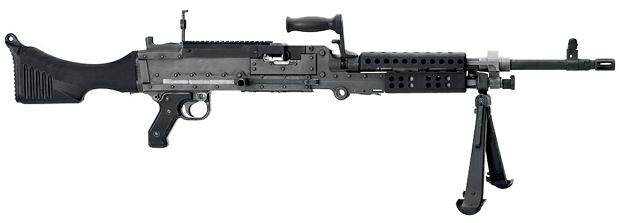I wonder why they didn't ever work at improving on the BAR design, giving it a larger capacity magazine, or some kind of belt feed option, and quick change barrel.
There are a number of practical reasons, not the least of which is cost. Another factor is legalitites (which also cost), and then it gets into what services think they need, what serves which purpose, best vs good enought, and did I mention, cost?
The BAR was designed, and built like all Browning's other arms, it was made to last. Designed decades before military thought moved to more "disposable" designs, the BAR was made like any sporting and contemporary firearms, built to give a lifetime of service without wearing out the major components just from use.
Other than some handguns, nothing from that era had a quick change barrel in the sense we use it today. Even Browning's designs that did feature a field changeable barrel needed to have headspace and timing set each time the barrel was changed. The modern "yank one out and slap another in" fixed headspace system common today wasn't used, most likely because there was no perceived need.
As to larger magazines, why? Sustained fire is what belt feeds (and specifically water cooled) is for. Also, try to get low prone with a 30rnd mag sticking out the bottom of the gun. Bren guns get bigger mags, but they go in the TOP of the gun.
Belt feed the BAR? OK, sounds good, but then you don't have a BAR anymore. Its not as simple as cutting a hole in the side of the receiver for the belt to go through. Other existing machinegun designs fill the need, so modifying the BAR is a waste of time, and money.
And speaking of money, note that armies buy weapons slowly during peace, budgets are tight, and even modifying existing stocks of arms (cheaper than buying new, usually) is tough to get approval for. And then there is the little legal issue of who owns the design, again, that is money...
When the fighting starts, armies buy guns, in large numbers, and existing designs get a big advantage, because they are already in production. You might have a better gun, in some ways, but if you can't deliver 1,000 next month, you will lose out to the guy who can deliver something that already is known to work.
The BAR, while not the best of all possible designs available at the start of WWII was in inventory, did work, and we could get more, starting
tomorrow...
And as to getting something "better" later, well, why? We got all these BARs already....
Personality, both in the military, and in the political side (funding, etc.) also plays a big part. It shouldn't, but it does. History has many examples of someone have a good, possibly even superior design, but because the inventor ticked off somebody (bureaucrat in, or out of uniform) it doesn't get adopted. OR someone's personal prestige becomes part of the process, creating the same result, if for slightly different reasons.
Maybe the new design is just barely better, but not enough to justify the expense of changing. History is full of examples of this, to one degree or another. Even the M1 Garand design had to be modified extensively before the Army would adopt it.
We never seriously considered major changes to the BAR, there was at first, no need, and then, there was no time. And, really while decades later, some people did "built a better mousetrap" in some ways, getting US to adopt it couldn't happen until some fundamental changes in our military philosophy took place first.

